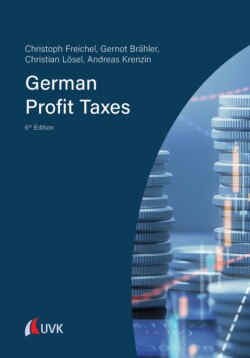German Profit Taxes

Реклама. ООО «ЛитРес», ИНН: 7719571260.
Оглавление
Christoph Freichel. German Profit Taxes
German Profit Taxes
Preface
Table of contents
List of abbreviations
1Introduction to German profit tax law. 1.1The importance of taxes
1.2Tax burden and tax justice
1.3The three tax disciplines
Note
1.4The tax system. 1.4.1Earnings of the state
1.4.1.1Taxes
1.4.1.2Fees
1.4.1.3Contributions
1.4.1.4Special levies
1.4.2Classification of the tax types
Note
1.4.3Taxation terminology. 1.4.3.1Taxpayer and/or taxable subject
1.4.3.2Subject of taxation and/or taxable object
1.4.3.3Tax base
1.4.3.4Tax threshold, tax allowance, deductible amount
Note
1.4.3.5Tax rate and tax scale
Note
1.4.4Tax sovereignty
Note
Summary
Questions
Literature
2Personal income tax. 2.1Basic principles of personal income tax. 2.1.1Characterization, importance and principles of personal income tax. 2.1.1.1Legal basis
Note
2.1.1.2Characteristics and demarcation of the personal income tax
2.1.1.3Fiscal and economic importance
2.1.1.4Principles of income taxation
2.1.1.5The two forms of income tax assement
Note
Note
Summary
Questions
2.1.2Personal and impersonal liability for personal income tax
2.1.3Personal liability for personal income tax
2.1.3.1Types of unlimited tax liability
Note
Note
2.1.3.2Types of limited tax liability
Note
Note
2.1.3.3Problem of double taxation
2.1.4Impersonal liability for personal income tax
2.1.4.1The types of income
2.1.4.2Determination of the personal income tax
2.1.4.3Classification of earnings and expenses
Note
2.1.5Temporal assignment. 2.1.5.1Assessment period and determination period
2.1.5.2Fiscal year
Note
Note
Summary
Questions
Literature
2.2Determination of taxable income
2.2.1Determination of income. 2.2.1.1Overview of the methods of determining income
2.2.1.2Determination of profit
Note
Note
Note
Note
2.2.1.3Determination of surplus income
Note
2.2.2Seven types of income
2.2.2.1The profit income types
Note
Note
Note
Note
Note
Note
Note
Note
Note
Note
2.2.2.2The surplus income types
Note
Note
Note
Note
Note
Note
Note
2.2.2.3Compensation and income from previous employment (Sec. 24 EStG)
Note
2.2.3Determination of the total amount of income. 2.2.3.1Elderly allowance (Altersentlastungsbetrag)
2.2.3.2Tax allowance for single parents
2.2.3.3Deduction for farmers and foresters
Summary
Questions
2.2.4Fiscal treatment of losses
2.2.4.1Loss compensation
Note
Note
2.2.4.2Loss deduction
Note
Note
Summary
Questions
2.2.5Special expenses. 2.2.5.1Concept of special expenses
Note
2.2.5.2Unlimited deductible special expenses
Note
2.2.5.3Limited deductible special expenses
Note
Note
Note
Note
Note
Note
2.2.6.Extraordinary expenses. 2.2.6.1Concept of extraordinary expenses
Note
2.2.6.2Extraordinary expenses in general cases
2.2.6.3Extraordinary expenses in standardized cases
Note
Summary
Questions
2.2.7Family benefit compensation
Note
Note
Summary
Questions
2.2.8Assessment basis and scale. 2.2.8.1The taxable income
2.2.8.2Scaled income tax
Note
2.2.8.3Special rates according to Secs. 34 and 34a EStG
Note
Note
Note
Note
2.2.8.4Determination of the personal income tax to be assessed
Note
2.2.8.5Determination of the final payment and/or the refund entitlement
Note
Note
Note
Summary
Questions
Literature
2.3Partnerships
2.3.1Co-partner income
Note
Note
Note
2.3.2Other partners of a partnership
Summary
Questions
Literature
3Corporate income tax. 3.1Basic principles
Note
3.1.1Characteristic features
Note
Note
3.1.2Personal tax liability
3.1.2.1Unlimited tax liability
Note
3.1.2.2Limited tax liability
3.1.3Tax exemption
3.2Tax assessment basis. 3.2.1Determination of taxable income
Note
3.2.2Adaptations of the commercial balance sheet to the tax balance sheet
3.2.3Additions and deductions to determine the taxable income outside of the balance sheet
3.2.3.1Hidden profit distributions
Note
Note
Note
Note
3.2.3.2Hidden equity contributions
3.2.3.3Tax-exempt income from investments in accordance with Sec. 8b (1) KStG
3.2.3.4Non-deductible expenditures in accordance with Sec. 10 KStG
3.2.3.5Non-deductible expenditures in accordance with Secs. 4 (5), (5b), 4h, 4j EStG, Secs. 8a, 8b (3) and (5) KStG
Note
Note
Note
3.2.3.6Donations
Note
3.2.4From the total amount of income to the remaining corporate income tax payment/refund
Summary
Questions
Literature
4Trade tax. 4.1Basic principles. 4.1.1Characterization of trade tax
Note
4.1.2Subject of taxation
Note
Note
4.1.3Personal tax liability
Note
4.2Business profit
Note
4.2.1Additions under Sec. 8 GewStG
Note
Note
4.2.2Deductions under Sec. 9 GewStG
Note
4.2.3Loss carryforward
4.2.4Tax allowance, federal tax rate, municipal rate and advance payments
4.3Breakdown
Note
4.4Lump-sum crediting of trade tax
Note
4.5Final question on trade tax
Summary
Questions
Literature
5Legal neutrality of taxation. 5.1Principle of legal neutrality of taxation
5.2Approaches for the implementation of legal form neutral taxation in Germany
Note
Literature
6Final comprehensive case. 6.1Information regarding corporate income tax
6.2Information regarding personal income tax
6.3Solution notes
6.4Solution. 6.4.1Determination of the taxable income/provision for trade tax/provision for corporate income tax
6.4.2Calculation of the tax liability for 2018
6.4.2.1Application of the flat-rate withholding tax within the meaning of Sec. 32d EStG
6.4.2.2Application of the partial-income method within the meaning of Sec. 3 no. 40 lit. d EStG
List of figures
List of tables
Translations. English – German
German - English
Index
Отрывок из книги
Christoph Freichel, Gernot Brähler,
Christian Lösel, Andreas Krenzin
.....
2.2.6.1Concept of extraordinary expenses
2.2.6.2Extraordinary expenses in general cases
.....